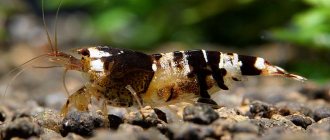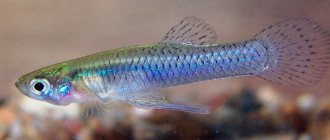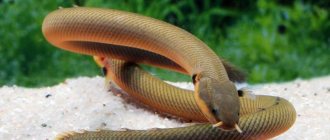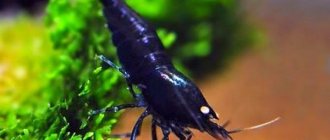Modern aquarists have long gone beyond the traditional keeping of fish. Today, in artificial tanks you can increasingly find other aquatic inhabitants - turtles, frogs, crustaceans, snails. Even a shrimp can no longer be called a rare aquarium inhabitant. Such diversity is impressive, but only if the company is chosen wisely and everyone coexists peacefully. All unusual creatures are of interest, and aquarium shrimp are no exception. Who do these crustaceans get along with, and how difficult are they to keep?
Shrimp in nature
These crustaceans can be found all over the world - they live in both fresh and salt water. However, there are many varieties of shrimp, and each of them has its own habitat:
- red-nosed shrimp, distinguished by their colorful appearance, prefer to live in the rivers of Venezuela, this is their homeland;
- representatives of the fan varieties love the cool freshwater waters of Panama;
- Amano shrimp live only in Japan and Korea, choosing cold mountain rivers for their habitat.
Almost all successfully domesticated shrimp come from various Asian regions. Shrimp are crustaceans and belong to the phylum arthropods. But, unlike marine crustaceans, they have jaws , thanks to which the creatures not only move, but also capture and hold food.
In addition, aquarium shrimp have five pairs of legs and a rather massive tail , which helps them escape from enemies. After all, with the help of it, individuals can move quickly and spasmodically. Aquarium shrimp are very modest in size, but at the same time they have an excellent sense of smell and touch, which is provided by elongated antennae.
In addition, the eyes of these creatures can rotate, contributing to an expanded visual range - it is difficult for enemies to catch these big-eyed inhabitants by surprise. And such unusual organs of vision are very helpful in finding food. The oropharyngeal system of shrimp is quite complex: it includes three jaws, the task of which is to grind food, as well as jaws, which hold food in the mouth. Other limbs help these arthropods grab food and crawl. The size of individuals depends on their gender, it varies between 3-8 cm.
Habitat
Ternetia lives in South America in the rivers Mato Grosso, Paraguay, Rio Negro and Guapora. The fish prefers slow-moving waters with a lot of plants. In such places, the water is shaded from the sun by tree branches. The water there is soft and acidic, and its color is dark due to the large number of branches in the water. Thorns swim mainly in the upper layer of water and eat insects that have fallen into the water.
Features of shrimp
Most freshwater shrimp are omnivores whose diet is based on lower aquatic vegetation. In addition to being omnivorous, they are distinguished by high endurance.
It is most interesting to observe shrimp in the daytime, when they are most active - then the crustaceans quickly move along the ground surface, looking for food, and they are also able to deftly crawl along the leaves of plants.
When the shrimp senses danger, it begins to move quickly, making jerking movements due to the contraction of the tail. These creatures are prone to regular molting; they shed their shell shell, consisting of chitinous plates. During this period - 2-3 days before molting and 1-2 days after - they do not eat shrimp.
When shrimp are freed from the old cover, they hide in secluded places - plants, under pebbles or in grottoes, and for good reason - their soft tissues are left without a hard shell that performs protective functions.
After shedding their “skin,” crustaceans recover damaged or lost limbs. Regeneration processes in young animals are the most intense, while in adults they are slow and gradual.
Bad neighbors
Most aquarium fish are neutral towards their arthropod neighbors and attack them only under certain circumstances. Such a provoking factor may be increased water temperature, mating season, fasting, or simply an unfortunate coincidence of circumstances. Thus, the compatibility of shrimp and swordtails (as well as most other viviparous species) can range from neutral ignorance to aggressive extermination. This intermediate category also includes large platies, barbs, brochis, girinocheilus, cardinals and rhodostomus.
Despite the fact that cockerels are very aggressive towards shrimp, there are examples of their peaceful coexistence.
Of course, there are also species with which it is simply impossible for arthropods to live peacefully with them. Most often, these are traditional aggressors and predators, such as rooster fish: shrimp and a rooster fish will not live even a day in the same aquarium, since the entire flock of unfortunate crustaceans will be exterminated in the very first hours of their acquaintance. The same deplorable indicator of compatibility of shrimp and gourami, cichlids (including discus fish), and various goldfish.
Once again, it is worth noting that the division of fish into three categories of compatibility is rather arbitrary, since under different conditions the nature of interspecific relationships can vary greatly . For example, it is not uncommon for aggressive cichlids and characins to completely ignore large schools. Before carrying out the mass “addition” of certain shrimps into the aquarium, it is recommended to add a couple of test specimens, which will make it possible to study the reaction of the fish to new neighbors. And of course, we should not forget about dense vegetation, the presence of which is beneficial for these tiny arthropods.
Keeping aquarium shrimp
Freshwater crustaceans do not require special conditions; even a beginner can keep and care for them. For one and a half dozen individuals, a 10-15 liter tank is enough. However, it is worth considering that these crustaceans are quite prolific, and sooner or later the number of inhabitants will increase, which means it is better to immediately place them in a more spacious aquarium.
These creatures look most impressive against the backdrop of black soil, but here you can rely on your own taste. The most suitable conditions for keeping aquarium shrimp are:
- Water temperature – 24°-25°С. Although shrimp can live if this parameter drops to 15°C or rises to 30°C, it is still better not to test the inhabitants for viability.
- Heating is not required if the air temperature in the house does not drop below 17°C.
- Aeration is necessary - crustaceans react very sensitively to a lack of oxygen in the water.
- Live vegetation is required - it is best to plant Java moss in the tank; shrimp use it as a hiding place and for cleaning. Beginners are advised to start with unpretentious plants - pistia or hornwort.
- It is necessary to filter the water - you just need to put a nylon multilayer mesh on the end of the filter. If the device creates a strong current, it can be reduced using special nozzles.
- Lighting – shrimp usually do not need additional light sources, but plants need moderate lighting for growth and development.
Particular attention should be paid to the quality of water, since aquarium shrimp immediately react to changes in its chemical composition. For replacement, you can only use clean, well-settled water. It is enough to just add water containing chlorine once, and the crustaceans will begin to get sick and die.
In addition, it is important to avoid the appearance of any chemical impurity in the environment. Do not use sprays or fresheners in the room where the shrimp tank is located. It is advisable to regularly ventilate the room. Also, shrimp do not tolerate increased concentrations of nitrogenous components very well.
Who do shrimp get along with?
Various aquarium inhabitants love to feast on these small crustaceans, while the shrimp themselves are peaceful, friendly and unobtrusive. In order not to endanger them, you should take the issue of choosing neighbors seriously. It is best to attach shrimp to small, non-aggressive fish - neon, guppies or zebrafish. They also feel good in the company of snails - both of them will not be attacked.
But when keeping crustaceans with barbs, angelfish, some large cichlids, loaches or even swordtails, you can expect trouble - the shrimp will have a hard time. Salvation for arthropods can be various shelters and dense vegetation; this is the only way they can avoid reprisals from determined predators.
Good neighbors
Neons are excellent neighbors for all types of shrimp.
First of all, it is worth saying that it is impossible to give a definite answer to the question of what fish shrimp get along with. There is no universal compatibility table for shrimp, since this parameter depends on many factors: first of all, the size of the aquarium, its level of population, including plants, landscape, temperature conditions, abundance of feeding and even the individual characteristics of each individual aquatic inhabitant. Therefore, in this matter you can only rely on personal subjective experience and the experience of other aquarists .
If we talk about specific species, then it is best for shrimp in an aquarium with fish to find a common language with the various “orderlies” of the aquatic environment. For example, Siamese algae eaters can live with rili shrimp. And not only the Siamese algae eater and shrimp are compatible in the same environment; all representatives of the genus crossocheilus (relatives of the above-mentioned algae eaters) get along well with unpretentious arthropods. Shrimp and ampullaria coexist well; they simply live in different worlds and have no idea about each other’s existence. Also, do not forget about a variety of catfish: the compatibility of catfish and shrimp is well known to aquarists, because these bottom-dwelling fish have a very peaceful character.
Under favorable conditions, ampullaria are very prolific, which can lead an aquarium to a real disaster. But if a small population of shrimp is kept with the snails, then the arthropods will destroy almost all the small ampullaria, maintaining the natural balance of the ecosystem.
Another large category of fish with which shrimp get along in the aquarium includes a variety of small, non-aggressive species. The compatibility of neons and shrimp can be estimated at almost 100%. The group of ideal fish for shrimpers also includes dwarf guppies, zebrafish, microrasboras, microplates, neon irises and parotocinclus.
Conditional table of compatibility of shrimps with aquarium fish.
Shrimp feeding regime and diet
Shrimp are omnivores and spend most of their waking hours searching for food. They are real orderlies of the underwater world - they eat dead areas of plants, the remains of other inhabitants (if any are found), and even microscopic particles of food that have settled on the ground. In general, everything you can profit from.
The main menu of shrimp is already available in the tank; the owner only needs to feed his charges a couple of times a day. It is not recommended to do this more often. You should not give food to crustaceans on the day of a water change when they feel hungry; they are more resistant to stressful situations and other undesirable changes.
Shrimp will eat any food that is offered to them. This can be either dry daphnia or concentrated, balanced branded diets. Some manufacturers produce special menus for shrimp; they meet all the needs of these unusual creatures and are considered the best option. It is advisable to alternate food so that the inhabitants receive everything they need and their menu is varied.
How to care for a shrimp tank
Caring for such a tank is practically no different from caring for a container in which fish live:
- water is changed weekly, approximately 30-35% of the total volume;
- soil siphoning is performed 1-2 times a week, a fairly easy procedure;
- biological waste - snail shells, dead plants, etc. should be removed as they appear.
Any activities related to the invasion of shrimp habitat should be carried out as carefully as possible - these creatures are smaller than most fish, and they can be accidentally crushed or even killed. Otherwise, there are no particular difficulties.
Incompatible fish
For small species of angelfish, angelfish are dangerous; large and hostile species of fish pose a danger to the angelfish themselves.
Incompatible fish species:
- African cichlids;
- South American cichlids;
- discus;
- goldfish;
- cockerels;
- guppy;
- koi carp;
- astronotuses;
- analysis.
African and South American cichlids
Cohabitation with African and South American cichlids is impossible. They have an aggressive character and love to start fights. Calm angelfish become stressed, get injured, and remain hungry.
Discus
Discus fish are not suitable for living together with other fish; they will only get along with individuals of their own species. The predatory nature and aggressiveness of discus fish leads to fights.
Goldfish
Goldfish and angelfish will not be suitable neighbors due to their different habitat conditions. Pterophyllums are heat-loving and demanding of water purity. Goldfish prefer cool water temperatures and like to dig up soil and stir up mud. Angelfish and goldfish do not get along because of their different personalities. Angelfish are active and aggressive to goldfish. They bite, tear off fins, and start conflicts.
Cockerels
The compatibility of cockerels with angelfish is low. These beautiful, colorful fish from the genus Labyrinthidae are easy prey for angelfish. Their bright colors awaken hunting instincts. The aggressiveness of pterophyllums towards males is especially noticeable during spawning. The cockerels become live food. Therefore, they cannot be kept together.
Guppy
Small and bright guppy fish will awaken the predatory instinct in pterophyllums even when living together from an early age. When living with large angelfish, predators will exterminate all the inhabitants of the aquarium. Therefore, angelfish and guppies should not coexist in the same space.
Koi carp
Koi carps are large in size. Small individuals are eaten by carps.
Astronotuses
Astronotus are voracious and aggressive towards other fish.
Breeding aquarium shrimp
When it comes to reproduction, shrimp are completely independent - they do not need help or special conditions. If you take good care of them, individuals that have reached sexual maturity will soon begin to produce numerous offspring. If the female is ready to reproduce, she gives a signal to the males in the form of pheromone secretions. And then you can observe a real race - the males begin to rapidly rush around the tank in search of the supposed “bride”.
A male can spend more than one hour to find a female, and mating lasts no more than a second. After fertilization, a “saddle” is formed in the female’s back area - in cherry shrimp it is yellow, in special shrimp it is gray. In fact, it is the eggs that show through at a certain stage of development.
Afterwards, the female molts, and the eggs end up under the abdomen. And after 21-28 days the fry appear. Young animals do not require special care; the babies immediately eat what their parents eat. They hide in dense vegetation and swim in jerky movements.
Not all shrimp are easy to breed, and if there are no problems with neocardine cherry and neocardine special, then to obtain offspring from Amano and filter feeders it is worth gaining knowledge and experience.
Diseases of aquarium shrimp
Despite their relative vitality, these creatures can get sick, like other inhabitants of an artificial tank. The main problem with shrimp is a variety of parasites that can live on the shell, gill valves or internal surfaces, affecting muscle tissue, nerve plexuses, and the heart. Unfortunately, when infected with parasitic organisms, the shrimp dies, since such diseases cannot be treated.
Another threat is pathogenic fungi, from which even those individuals that live in clean water that meets all the required parameters are not immune. Fungi gradually deprive the individual of nutrients and poison the body with toxic toxins. In this case, the risk of death of the inhabitant is very high.
Shrimp can also suffer from viral infections that are difficult to treat. No matter what the shrimp are sick with, the affected individuals should be removed from the general container into a separate tank and the water should be changed.
Freshwater shrimp are creatures with an unusual appearance, thin, graceful and at the same time quite dexterous. And if you provide them with decent conditions, they will become wonderful inhabitants of the aquarium, attracting attention and not letting the owner get bored.
online now
zebrafish and cherry shrimp, is it possible for them to live together and reproduce cherry shrimp without problems? 4 cherries, 10 zebrafish, 30l aquarium. stones, mini anubias 2 pcs valisneria but the thickets of valisneria are not large yet.
The cherries will have no problems at all.
Considering the habit of zebrafish to taste everything that floats in the water column, I’m not sure that everything will be wonderful.
Considering the habit of zebrafish to taste everything that floats in the water column, I’m not sure that everything will be wonderful.
In this case, there is absolutely no need to worry. Cherries coexist well in aquariums with a lot of fish. Even with cichlids. And with zebrafish, other cyprinids, characinka, and viviparidae, they will live just fine. The aquarist will then have problems with how to remove this plague from the aquarium..
what plague? shrimp? Why are the lights multiplying so actively?
what plague? shrimp? Why are the lights multiplying so actively?
Like cockroaches in a dirty kitchen. At first you are happy with every shrimp, then at some point there are too many of them. You think it’s time to remove them from the aquarium. But that was not the case. And if there are a lot of aquariums in the apartment, then they often start up on their own in free reservoirs. Well, of course, they don’t run across on their own, but with plants, a net, etc., it’s easy.
I don’t know about the zebrafish, but my teenage mollies happily devoured juvenile cherries. However, some of the shrimp still survived and the adults had to be caught and fed to the cichlids. Truly a plague. And if you consider that if you do not sort them by color (and in an overgrown aquarium this is almost impossible), then over time the shrimp begin to become more and more gray.
Well I do not know. My cherries just won’t multiply. As soon as the number reaches 30 in my 30 years, it’s some kind of pestilence. There are only 5 left and that’s it. Then they will pop up again and again there will be pestilence. And so it’s been like that for half a year already. And the fish are all alive and well. So I’ve never seen too many cherries in the aquarium. They’re kind of weird for me. They live with guppies.
Well I do not know. My cherries just won’t multiply. As soon as the number reaches 30 in my 30 years, it’s some kind of pestilence. There are only 5 left and that’s it. Then they will pop up again and again there will be pestilence.
This is exactly the case when someone reacts poorly to nitrogen in the water. But shrimp cannot tolerate excess nitrogen categorically.
Then there will be people again and again pestilence. And so it’s been like that for half a year already. And the fish are all alive and well. So I’ve never seen too many cherries in the aquarium. They’re kind of weird for me. They live with guppies.











